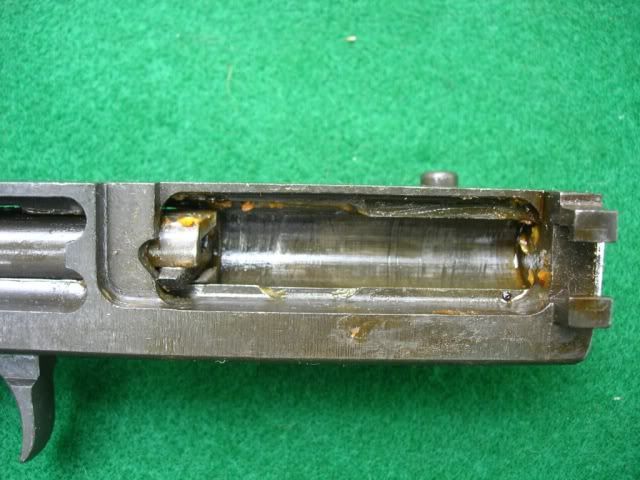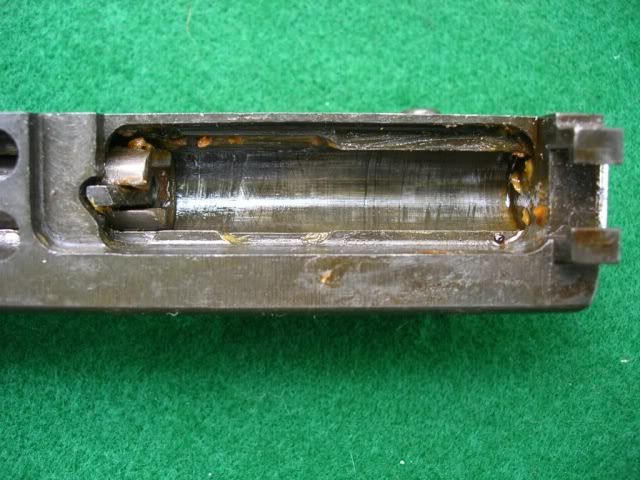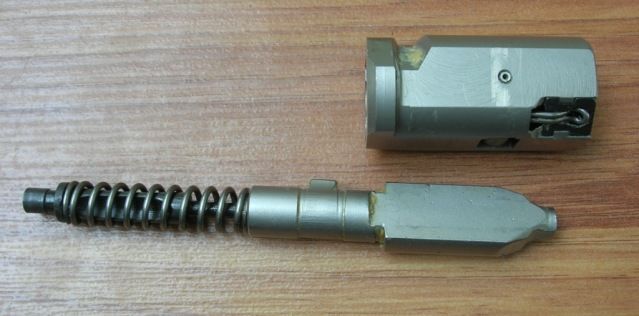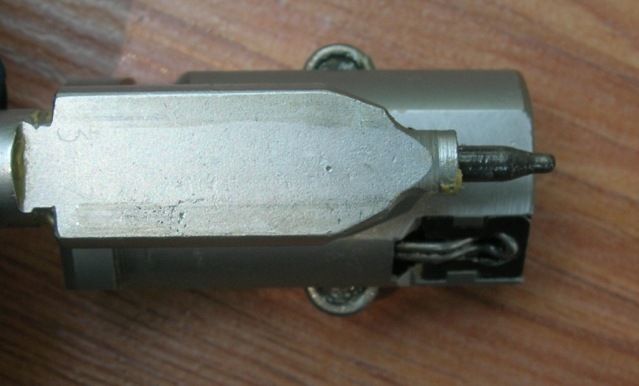
 |
|
|
#1 |
|
Senior Member
Join Date: April 29, 2012
Location: East Texas
Posts: 105
|
M1 Garand
Getting close to reloading my first rifle cartridge and it will be fired in the M1 Garand (for target only). I have some once fired HXP brass, and plan to use locally purchased H4895 and Winchester WLR Primers to save $$ on the hazmat fee associated with shipping. Also, using Winchester 150gr. Power-point bullets. Since I'm green at rifle reloading, I have a few questions:
__________________
1911 is Faster than 911 Last edited by Reef; August 10, 2012 at 03:13 PM. |
|
|
|
|
#2 |
|
Member
Join Date: August 23, 2011
Posts: 46
|
I prefer full length sizing all my reloads along with a slight crimp to ensure easy chambering. I know the primer pocket crimp has to be removed I've never had to do it but I've been told there r primer pocket reamers to remove this.
__________________
Buy'em for fun and love of guns not status symbols. |
|
|
|
|
#3 |
|
Senior Member
Join Date: December 26, 2004
Location: Louisville KY
Posts: 13,806
|
Full length resize for semiautos.
The crimp can be removed by simply buzzing it off with a chamfer bit and cordless drill. No need to trim once resized and under max. I like to set up my seating die to crimp some, not terribly necessary. Next time, try to find some FMJ bullets. |
|
|
|
|
#4 |
|
Senior Member
Join Date: November 14, 2008
Posts: 355
|
Reef, full length resizing is normally recommended when used in SA firearms but I've had no problems just neck-sizing HXP brass when feeding my M1, and I'm on my 6th reload of this lot of HXP. You might have a problem neck sizing only, IF you plan to use those loads in more than 1 rifle, but that's only conjecture on my part.
I've found the three small dimple crimps in HXP brass to be so small, that I've been able to remove them simply by inserting a new WLR primer. No problems there. I'd recommend trimming the cases to .008-.010 less than max. length to start with. If some are shorter than that to start with, I doubt you'll see any difference in accuracy, so I'd use those as is. I've also found my cases to grow .002-.003 per firing, depending on the loads used. Even if the bullets you're using have a cannelure, I haven't found a need to crimp reloads for my M1 at all. Set to the OAL recommended in your manual or longer if desired(as long as they feed well and don't hit the rifling when chambered. |
|
|
|
|
#5 |
|
Senior Member
Join Date: September 22, 2011
Location: Middle America
Posts: 518
|
"full length or neck resizing. should the crimp in the primer pocket of the HXP brass be removed, if so, how. if cases are under the maximum case length is there a need to trim. should I crimp during bullet seating"
Garands are grand! Your bullets, primers and powder are good for your first go at it. Starting loads are listed on the powder makers page; " http://www.hodgdon.com/ ". Your questions in order. Auto-loaders benefit from being full length re-sized. Some may disagree and that's fine, I always full length size all of mine. Crimped in primers are a pain, once. Depending upon you die set, you may need a 'military depriming tool'. Once the old primer is out, that ring of brass has to be removed or displaced. Depending on how may GI cases you have to do, a chamfering tool or pocket knife will get it done, or special tools can be bought. The best thing is, once it has been done, you never have to do that same piece of brass again. Trimming to length provides two things. The obvious of getting the brass back to the proper length. And consistency. Differing lengths of brass don't make for the best accuracy and if you do the crimp thing, you will have problems. Crimping... I don't, others do. No one wants bullet setback on chambering. I have found that case tension hold quite well. I feed ARs in .223/5.56 and .300 BlackOut, M1A/M14 in .308/7.62, and M1s in 30.06 and have not had any problem not crimping. Many will expound on crimping being required and I will not argue, I just don't. My advise is to load up some rounds without a crimp and see how much pressure it takes to push the bullets deeper into the case. If you brass gives and they slip in, crimp. One other thing. Garands were designed for a smaller 28 caliber round but Gen MacArthur (the elder one) refused to sign off on the caliber change. The weapon was reworked to the standard of the day, the 30.06. They were not loaded to the extreme pressures that we have today. Garands work beautifully in a power curve that suits them and the 4895s powders are in that burn rate, but don't look for the highest velocities. There are many who know vast amounts about the Garand and if you ask, they will educate you well. Enjoy your Garand for many years. OSOK |
|
|
|
|
#6 |
|
Senior Member
Join Date: June 4, 2007
Location: Upstate SC
Posts: 1,943
|
I always FL size my Garand brass in RCBS SB dies. The dimple primer crimps are not an issue, Lyman makes a reamer that works fine for this. I swage mine with the RCBS swager, but you can buy that later.
IMR 4895 works very well in the M1; I use WW748 or BLC2 in mine because I like the way they meter through the Dilllon measure. Overall length if under 2.485" is fine; I trim mine at 2.490 or longer. As long as you don't exceed 3.300" on your loaded rounds, you're good to go. Enjoy shooting with your old soldier friend; he probably has some real good war stories to tell. CB.
__________________
If you want your children to follow in your footsteps, be careful where you walk. Beware the man that only owns one gun; he probably knows how to use it. I just hope my ship comes in before my dock rots. |
|
|
|
|
#7 |
|
Staff
Join Date: March 4, 2005
Location: Ohio
Posts: 21,061
|
Neck-only sizing in a semi-auto encourages both slamfires and out-of-battery firing. It should never be done in a floating firing pin gun like the Garand, M14/M1A or AR platforms. It contributes to these problems by creating additional resistance to chambering that causes the bolt hesitation. When that happens, inertia drives the floating firing pin into the primer. Usually it's not hard enough to set it off, but every once in awhile it is. The Garand's safety bridge blocks the firing pin from slamming forward when the extractor snaps closed over a case rim as the bolt starts to close, but when the bolt is not yet that far forward in the action it does nothing for you.
Both unintended kinds of firing are dangerous, but especially the more rare OOBF's, as they usually destroy at least parts of the gun. The bottom line is: always full-length resize for the Garand, M14/M1A, and AR. Seating primers properly is another major necessity to prevent slamfires and OOBF's. You can sometimes get away with high primers (bad for reliability and accuracy) on bolt guns, but not with the fast closing bolts on the semi-autos. Some individual guns are less prone to slamfires and OOBF's than others because of how their tolerances stack up, but there's only one sure way to find out if your's is or is not one of them, so just seat primers properly to avoid it becoming an issue in the first place. The primers must be seated below flush with the primer pocket rim. Ideally, a narrow strip of 16 lb typing paper should fit between the primer and a flat edge, like a flat screwdriver blade that is bridging the primer pocket. If it doesn't, push the primer in harder. Some additional resistance to the risk of the two unwanted firing events may be obtained by using the less senstive military sensitivity specification primers. Currently there are two on the market for Large Rifle size that I am aware of, and three for Small Rifle (for the ARs)¹. The two LR sizes available for the Garand are the CCI #34 and the TulAmmo KVB762. Both work well. The latter are less expensive, a little harder to seat fully, but seem to produce lower velocity spread for me, at least with stick powders. Some spherical propellants may prefer the warmer CCI #34. I recommend choosing one of these. The odds of a problem with a standard primer in their place is small, but it's just not zero. When you consider injury from gun blow-ups can hurt someone on an adjacent firing point, I prefer the extra insurance even if I'm willing to take a risk for myself. The HXP has pretty wimpy staked crimps. You may or may not be able to seat past them without doing anything. Fellows at the CMP forums report differences in that brass from different years, so you can only tell by trying. You can remove the crimps with a light touch of a chamfer tool as described. However, some cases have primer pockets that are tighter overall than others, so for ease of seating and better certainty of achieving adequate primer seating depth, you may need to use a primer pocket profile reamer (a number of brands are available) or cutter (one is made for the Wilson case trimmer), or a primer pocket swaging tool (RCBS for a press mounting one and they now have a bench version, and Dillon is the Cadillac bench version, still, I believe). Trimming is done on an as-needed basis. Just be sure to measure the case length AFTER full length resizing, as during sizing is when the neck grows. The inexpensive Lee trimmers do a perfectly good job for minimal cost. They're just slower than the more expensive tools unless you add a Lee Zip Trim or use them in a drill press. If you use the RCBS X-die, you never have to trim after the first time, but that first time is still there and it requires trimming extra short (2.474" for .30-06). Bullet jacket metal has an excellent degree of friction with brass, so crimping is not required unless you intend to drop the ammo into a battle zone or subject it to other sorts of extraordinarily rough handling. If you eject a loaded round, it can't hurt to check it for slight setback before chambering again, just to be sure, but for a single chambering I've never seen or heard of an issue. Military rounds are often crimped, but if you pull one they also often are held in place by pitch sealant in a case neck that grips the bullet very lightly, so in that case extra ruggedness can be helpful. But a handloader won't normally under resize a neck that way except with some methods of loading for singly loaded bolt gun rounds. Certainly not for a self-loader. Nick ¹For small rifle the three military sensitivity primers are the CCI #41, the TulAmmo KVB556M, and the new Federal GM205MAR just out this year.
__________________
Gunsite Orange Hat Family Member CMP Certified GSM Master Instructor NRA Certified Rifle Instructor NRA Benefactor Member and Golden Eagle Last edited by Unclenick; August 10, 2012 at 04:05 PM. |
|
|
|
|
#8 |
|
Senior Member
Join Date: April 29, 2012
Location: East Texas
Posts: 105
|
Again, some excellent feedback! I appreciate the insight from all the experience on this site and someday I hope to be able to contribute TO, instead of TAKE from, this forum! I’ll gladly field any pilot related questions, as that is my only area of expertise, maybe a different forum LOL.
__________________
1911 is Faster than 911 |
|
|
|
|
#9 |
|
Staff
Join Date: March 4, 2005
Location: Ohio
Posts: 21,061
|
It'll only be a different forum if you can't have a gun mounted on the plane.
__________________
Gunsite Orange Hat Family Member CMP Certified GSM Master Instructor NRA Certified Rifle Instructor NRA Benefactor Member and Golden Eagle |
|
|
|
|
#10 |
|
Senior Member
Join Date: October 19, 2005
Location: Tx Panhandle Territory
Posts: 4,159
|
Wouldn't it be neat to see a ball turret mounted somewhere on a Super Cub?
__________________
Rednecks... Keeping the woods critter-free since March 2, 1836. (TX Independence Day) I suspect a thing or two... because I've seen a thing or two. |
|
|
|
|
#11 | ||
|
Senior Member
Join Date: May 27, 2007
Posts: 5,261
|
Quote:
First of all that term is a post 1960’s creation. The further I go back, I don’t find it called a "safety bridge" In WW2 training films and in a WW2 Carbine manual it is called a firing pin retraction cam. I think the term “safety bridge” is a term which has no meaning in reality. Secondly, the receiver bridge is a hard surface and when you think of it, that firing pin is going to hit the thing and bounce off. Given enough impact velocity it will travel all the way back into the bolt and bounce forward. Instead of being a “safety bridge” this thing creates multiple impacts on any primer in reach. Here is a carbine firing pin retraction cam, much easier to understand than a Garand. As the bolt rotates to full closure you can see that the cam decreases in thickness. The thickest section is quite short compared to the cam. There is plenty of opportunity for the firing pin to hit the primer.   The firing pin retraction cam does little if nothing in preventing slamfires. I am of the opinion that the military controlled slamfires through primer insensitivity. During the slamfire investigations of the M16, you find a statement that the Army always used the FA34 primer for the 30 caliber guns. That was their own special insensitive primer, something that was not available to civilians till the CCI #34 primer came on the market in 1999. Of course they did not allow over long, or fat cases, or high primers. When you look at the Garand/M14/M1 carbine/mini 14, these mechanisms always have the centerline of the bolt inline with the primer all the way up to lock up, the firing pin is not retracted in any sense until cam down, and the effectiveness of that receiver bridge in keeping the firing pin from hitting the primer is questionable. Other designs, such as the AR15, the firing pin is positively kept back until cam down. You never hear of out of battery slamfires with AR’s even though you hear of in battery slamfires. Other mechanisms, the bolt faces tilt out of alignment until lock up, preventing contact between the firing pin and primer, and when you read of slamfires in SKS’s and FAL’s (for example), they are always in battery. I never read of slamfies in the roller bolts. It is impossible for the firing pin to reach the primer before lockup in a roller bolt. The firing pin spring is hideously strong and will not allow firing pin bounce. This design is very effective in preventing slamfires.    Quote:
__________________
If I'm not shooting, I'm reloading. Last edited by Slamfire; August 11, 2012 at 08:17 AM. |
||
|
|
|
|
#12 | |
|
Senior Member
Join Date: October 28, 2006
Location: South Central Michigan...near
Posts: 6,501
|
Quote:
|
|
|
|
|
|
#13 | ||
|
Senior Member
Join Date: April 29, 2012
Location: East Texas
Posts: 105
|
Quote:
Quote:
__________________
1911 is Faster than 911 |
||
|
|
|
|
#14 | ||
|
Senior Member
Join Date: October 28, 2006
Location: South Central Michigan...near
Posts: 6,501
|
Quote:
Quote:
Quote:
|
||
|
|
|
|
#15 |
|
Senior Member
Join Date: February 15, 2009
Posts: 8,927
|
dahermit, before 30 caliber match bullets were commercially available in the USA, folks winning high power matches and setting records used Sierra's 180 and 200 grain spitzer boatail hunting bullets. They were equal to and often better than the military arsenal 172-gr. FMJBT match bullets sold through the DCM to the public. Winchester and Western Cartridge Co. (Remington, too, possibly) sold their 180-gr. FMJBT match bullets at retail but their quality wasn't all that consistant between lots. Western Cartridge used a 190-gr. OPE (open point expanding) boattailed hunting bullet in 1960 for .308 Win. match ammo made for the US Olympic Team's 300 meter free rifles; it drove tacks!!
When Sierra finally came out with their 180 and 200 grain FMJBT match bullets, the best shots didn't see much difference in accuracy. Many shot their 180 hunting bullets through 300 yards and used either weigh match bullets at 600 yards through 1000. Nowadays, there's hunting bullets that shoot darned near as accurate as match bullets. It takes someone, a rifle and ammo comprising a system that shoots no worse than 2 inches at 300 yards to tell the difference. |
|
|
|
|
#16 | |
|
Senior Member
Join Date: October 28, 2007
Location: Upper Indiana
Posts: 609
|
Quote:
Ever shoot in compatition? |
|
|
|
|
|
#17 |
|
Senior Member
Join Date: April 29, 2012
Location: East Texas
Posts: 105
|
This has gotten a bit off track.
__________________
1911 is Faster than 911 |
|
|
|
|
#18 |
|
Senior Member
Join Date: February 15, 2009
Posts: 8,927
|
More often than not, fired cases from Garands usually don't chamber easily again from whence they came.
And there needs to be lots of case body spring back from firing to ensure reliable functioning of the Garands semiauto reloading system. It's best to use a case headspace gage (RCBS Precision Mic or equavalent) to use when setting up a full length sizing die so the fired case shoulder's not set back more than 3 thousandths. Any more and one's flirting with head separation. That bridge, call it safety, retracting, receiver or whatever one wants. . . . Gauges were made that measure its ability to prevent firing pin protrusion past the bolt face until the locking lugs were 75% back in battery, or something like that. And it also ensured the firing pin retracted as the bolt unlocked. Some 30 caliber Garands' receivers were scrapped during the Navy's Garand conversion process to 7.62 NATO barrels as they failed the "safety bridge" test with that gauge. M14's didn't have a gauge to check their receiver bridge. Nor were their any failures of that bridge as far as I know. Marine armorers I've talked with say none of the M14's they checked ever had a problem with that bridge. Some believe the M14 receivers were better made and hardened than Garand ones. Regarding the M1A commercial, semiauto only version, I've no idea how their bridges fared with use. |
|
|
 |
|
|